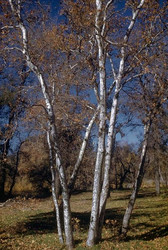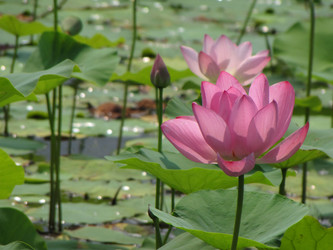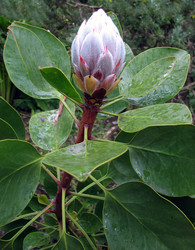Proteales
Austin Mast


This tree diagram shows the relationships between several groups of organisms.
The root of the current tree connects the organisms featured in this tree to their containing group and the rest of the Tree of Life. The basal branching point in the tree represents the ancestor of the other groups in the tree. This ancestor diversified over time into several descendent subgroups, which are represented as internal nodes and terminal taxa to the right.

You can click on the root to travel down the Tree of Life all the way to the root of all Life, and you can click on the names of descendent subgroups to travel up the Tree of Life all the way to individual species.
For more information on ToL tree formatting, please see Interpreting the Tree or Classification. To learn more about phylogenetic trees, please visit our Phylogenetic Biology pages.
close boxReferences
Endress, P. K. and A. Igersheim. 1999. Gynoecium diversity and systematics of the basal eudicots. Botanical Journal of the Linnean Society 130:305-393.
Hilu, K. W., T. Borsch, K. Müller, D. E. Soltis, P. S. Soltis, V. Savolainen, M. W. Chase, M. P. Powell, L. A. Alice, R. Evans, H. Sauquet, C. Neinhuis, T. A. B. Slotta, J. G. Rohwer, C. S. Campbell, and L. W. Chatrou. 2003. Angiosperm phylogeny based on matK sequence information. American Journal of Botany 90(12):1758-1776.
Hoot, S. B., S. Magallón-Puebla, and P. R. Crane. 1999. Phylogeny of basal eudicots based on three molecular datasets: atpB and rbcL sequences, trnK restriction sites and morphological characters. Annals of the Missouri Botanical Garden 86:119-131.
Magallón, S., P. R. Crane, and P. S. Herendeen. 1999. Phylogenetic pattern, diversity and diversification of eudicots. Annals of the Missouri Botanical Garden 86:297-372.
Savolainen, V., M. W. Chase, S. B. Hoot, C. M. Morton, D. E. Soltis, C. Bayer, M. F. Fay, A. Y. De Bruijn, S. Sullivan, and Y. L. Qiu. 2000a. Phylogenetics of flowering plants based on combined analysis of plastid atpB and rbcL gene sequences. Systematic Biology 49:306-362.
Savolainen, V., M. F. Fay, D. C. Albach, A. Backlund, M. van der Bank, K. M. Cameron, S. A. Johnson, M. D. Lledó, J.-C. Pintaud, M. Powell, M. C. Sheahan, D. E. Soltis, P. S. Soltis, P. Weston, W. M. Whitten, K. J. Wurdack, and M. W. Chase. 2000b. Phylogeny of the eudicots: a nearly complete familial analysis based on rbcl gene sequences. Kew Bulletin 55:257-309.
Soltis, D. E., P. S. Soltis, M. W. Chase, M. E. Mort, D. C. Albach, M. Zanis, V. Savolainen, W. H. Hahn, S. B. Hoot, M. F. Fay, M. Axtell, S. M. Swensen, L. M. Prince, W. J. Kress, K. C. Nixon, and J. S. Farris. 2000. Angiosperm phylogeny inferred from 18S rDNA, rbcL, and atpB sequences. Botanical Journal of the Linnean Society 133:381-461.
Title Illustrations

| Scientific Name | Platanus racemosa |
|---|---|
| Location | Alameda County, California, USA |
| Creator | Photograph by Charles Webber |
| Specimen Condition | Live Specimen |
| Source | Platanus racemosa; California Sycamore |
| Source Collection | CalPhotos |
| Copyright |
© 1998 California Academy of Sciences

|
| Scientific Name | Nelumbo nucifera |
|---|---|
| Location | cultivated, Olympic Park, Beijing, China |
| Specimen Condition | Live Specimen |
| Source | Lotus |
| Source Collection | Flickr |
| Image Use |
 This media file is licensed under the Creative Commons Attribution-NonCommercial License - Version 2.0. This media file is licensed under the Creative Commons Attribution-NonCommercial License - Version 2.0.
|
| Copyright |
©

|
| Scientific Name | Protea cynaroides |
|---|---|
| Location | cultivated at San Francisco Botanical Garden |
| Specimen Condition | Live Specimen |
| Image Use |
 This media file is licensed under the Creative Commons Attribution-NonCommercial License - Version 2.5. This media file is licensed under the Creative Commons Attribution-NonCommercial License - Version 2.5.
|
| Copyright |
©

|
About This Page
Austin Mast

Florida State University, Tallahassee, Florida, USA
Correspondence regarding this page should be directed to Austin Mast at
Page copyright © 2002 Austin Mast
All Rights Reserved.
Citing this page:
Mast, Austin. 2002. Proteales. Version 01 January 2002 (temporary). http://tolweb.org/Proteales/20708/2002.01.01 in The Tree of Life Web Project, http://tolweb.org/











 Go to quick links
Go to quick search
Go to navigation for this section of the ToL site
Go to detailed links for the ToL site
Go to quick links
Go to quick search
Go to navigation for this section of the ToL site
Go to detailed links for the ToL site